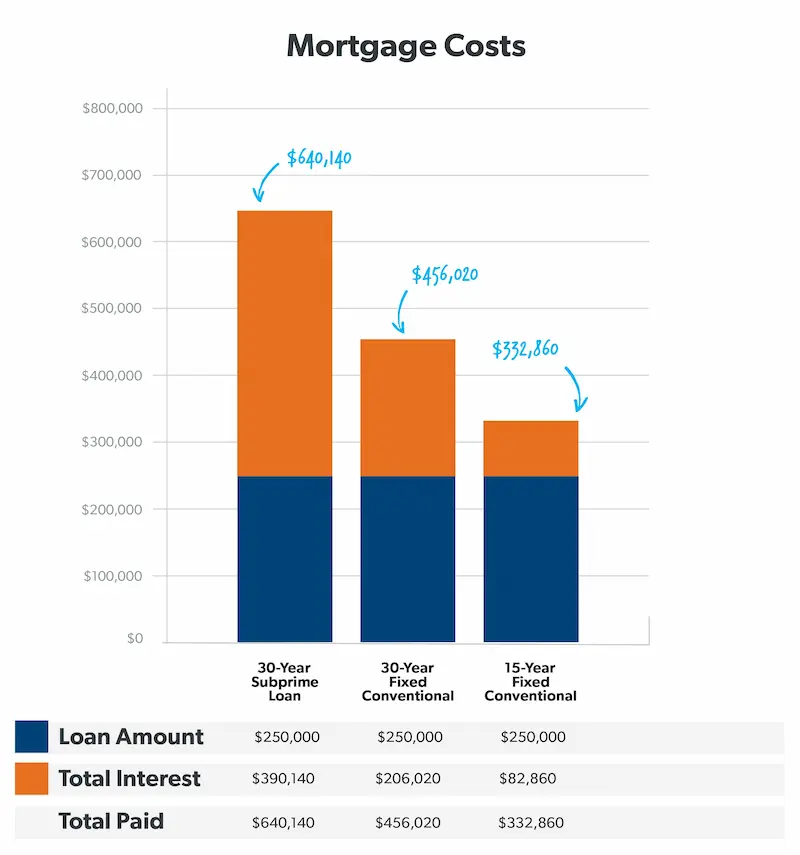Subprime financing involves lending to people with weak credit. Any credit score below 600 is regarded as unfavorable and may make loan approval harder.
What Is Subprime Lending?
We all need financial support at some time, whether to pay unforeseen bills or buy a home or automobile. Borrowing is wise in some instances. Traditional lenders aren’t always available, and conventional loans may not be an option for everyone.
Banks and credit unions give better terms to clients with strong credit, so subprime borrowers must go elsewhere. It is where prime rate and prime loans come into play, as they’re accessible to those with lower credit risk and offer more favorable terms. On the other hand, subprime mortgage loans are tailored to individuals with a less-than-ideal credit record.
Subprime loans are best for customers with credit scores below 600. Due to greater risk, these loans have higher interest rates. Subprime loans include credit cards, personal, vehicle, mortgage, and business loans. They provide credit to borrowers with a poor credit score and have contributed to the increase in subprime lending over the years, sometimes leading to a financial crisis.
What Exactly Is a Credit Score?
Credit ratings assist lenders in evaluating your payment history and debt-handling skills. They help determine who qualifies as prime borrowers and who poses a higher risk of default.
A credit score represents this capacity, and FICO scoring is typical. Your credit report significantly determines your credit score and eligibility for different loan types.
Your FICO score includes payment history, overall debt, credit history duration, categories of credit, and current credit queries. The result might vary from 300 to 850.
Subprime Credit Score: What Is It?
Lenders classify borrowers by credit scores, which may affect the types of loans they qualify for. These include the following:
- Over 800: Exceptional
- 730-799: Very good
- 650-750: Good
- 630-670: Fair
- 540-620: Subprime (subprime mortgage crisis)
- Lower than 540: Poor
Your credit score decides whether a bank or credit union will grant you a loan guaranteed approval unsecured credit cards for bad credit. High-credit-score borrowers obtain better loan conditions, such as prime mortgages and lower loan payments.
Traditional lenders may not lend to borrowers with FICO ratings between 550 and 620. GreendayOnline provides subprime consumers with personal loans with affordable rates and fair conditions. They offer various types of loans, such as installment loans, amortized loans, auto loans, and debt consolidation loans. These loans have different characteristics, such as initial interest rates for adjustable-rate mortgages and standard repayment loans for managing student loan debt. Consequently, this helps reduce the risk of loan default for borrowers with a subprime home loan.
How Do Subprime Loans Work?
Nontraditional lenders provide subprime loans that may involve mortgage-backed securities and interest-only loan options. These loans may influence the mortgage market and mortgage interest rates, affecting the balance sheets of financial institutions like Fannie Mae. To get a subprime loan, you must fulfill age and income restrictions.
Subprime loan applications are uncomplicated and may be completed in-store or online. GreendayOnline’s no credit check guaranteed approval payday loans procedure is fast, and you may obtain your money the following business day, helping borrowers access secondary markets for loans.
Here are some statistics on Subprime Loans:
| Statistic | Value |
|---|---|
| Number of subprime loans in the United States | 100 million |
| Average interest rate for subprime loans | 25% |
| Average term for subprime loans | 3 years |
| Percentage of subprime loans that are in default | 15% |
| Average amount of debt for subprime borrowers | $20,000 |
| Percentage of subprime borrowers who are late on their payments | 30% |
| Percentage of subprime borrowers who have declared bankruptcy | 5% |
| Riskiest subprime borrowers | Borrowers with credit scores below 620 |
| Safest subprime borrowers | Borrowers with credit scores above 660 |

What Are the Advantages of Subprime Lending?
Subprime financing, including options like rate home loan, subordinate lien loan, variable home loan, conventional repayment loan, and adjustable-rate subprime loan, is preferable standard lending. Non-traditional subprime lenders are convenient for borrowers, especially financial firms looking to ensure timely payments.
Subprime loan applications are speedier than regular loans. Traditional loan applications take days or weeks. Subprime lenders may help borrowers’ financial health, so many pick them.
Many subprime lenders offer flexible terms so that you may change your repayment plan. You may repay GreendayOnline’s personal loans according to your budget.
GreendayOnline can assist if you need a loan. We offer average loan options to suit your needs, including monthly payments on student loans and fixed-rate subprime loans. Flexible terms, affordable rates, and complete transparency characterize our personal loans.
The application is quick. Start your application now and receive your money tomorrow. Whether considering a grade paper loan, adjustable rate loans, or seeking the average auto loan interest rate, our bank loan program has you covered. We partner with the best banks for loan applications and provide credit default swap options for added security.
Frequently Asked Questions
What are subprime loans, and how do they differ from traditional loans?
Subprime loans are offered to borrowers with poor credit histories and have higher interest rates than traditional loans. Traditional loans require good credit scores and lower interest rates.
What were the key factors that led to the subprime mortgage crisis in the mid-2000s?
Key factors in the mid-2000s subprime mortgage crisis included lax lending standards, predatory lending practices, financial innovations like mortgage-backed securities, and a housing bubble.
How do subprime loans impact borrowers’ credit scores and financial stability?
Subprime loans can further damage borrowers’ credit if not repaid on time and trap them in debt, leading to foreclosure and bankruptcy.
What types of financial institutions typically offer subprime loans, and why?
Subprime lenders and non-bank mortgage companies typically offer subprime loans to capitalize on higher interest rates from riskier borrowers.
What regulatory measures have been put in place to prevent another subprime mortgage crisis in the future?
Regulations like Dodd-Frank increased lending oversight and established the Consumer Financial Protection Bureau to prevent predatory lending practices.

